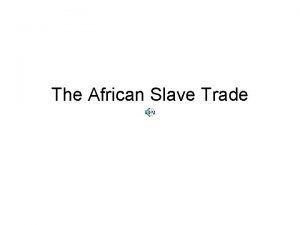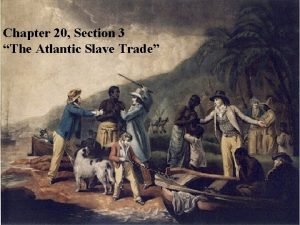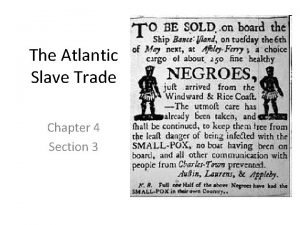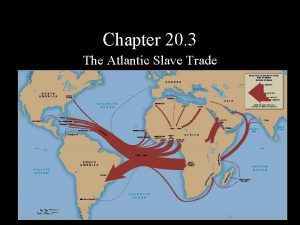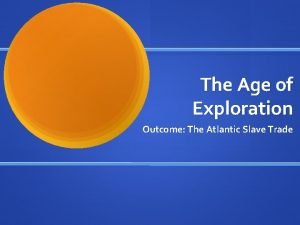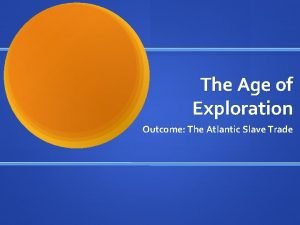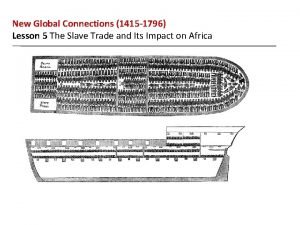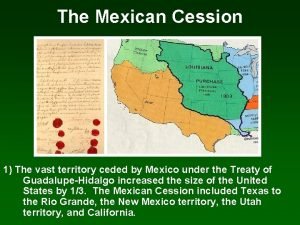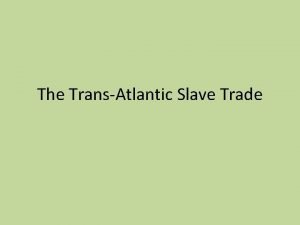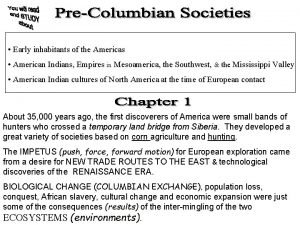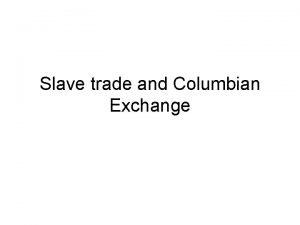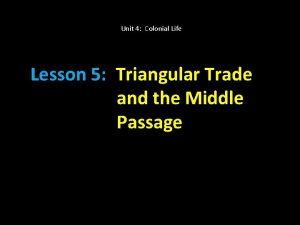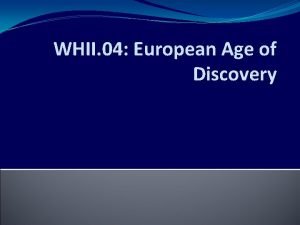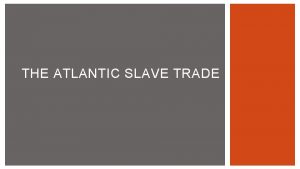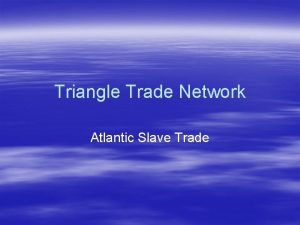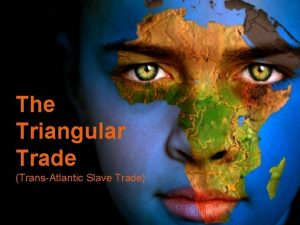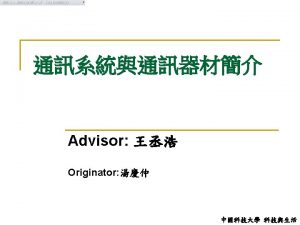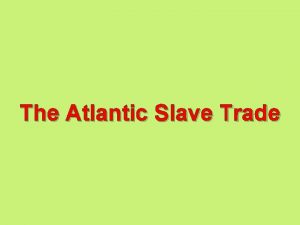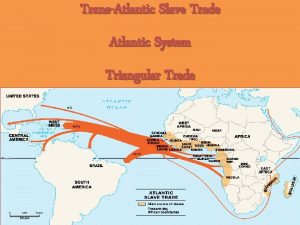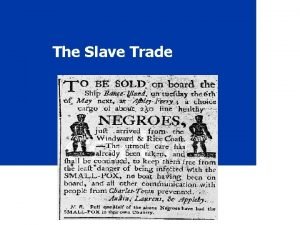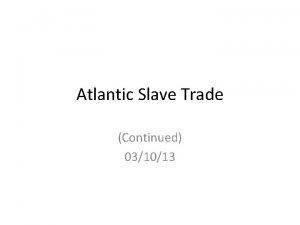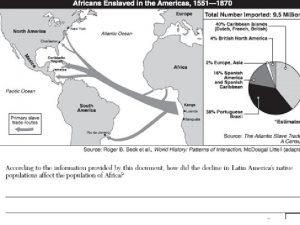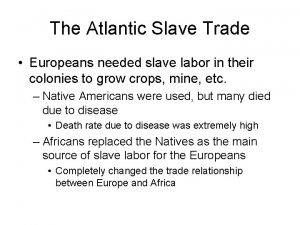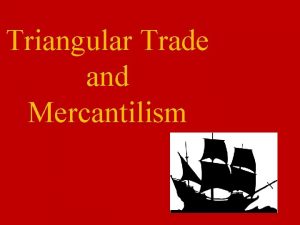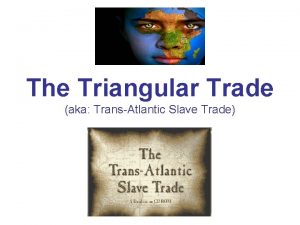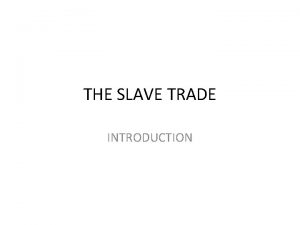The Atlantic Slave Trade Triangular Trade Lesson starter















- Slides: 15

The Atlantic Slave Trade Triangular Trade Lesson starter: 1. What is slavery?

We are learning to… • Describe the Triangular Trade process I can… • Summarise Triangular Trade • Complete a N 5 skills question

Background • Slavery is thousands of years old • However, the slave trade of the 1700 s (18 th century) was a new kind of slavery • why? • It was bigger than ever before – millions of Africans were used as slaves • It was racist – only Africans were sold into slavery • Slaves were the property of their owners – people were treated as goods • It was cruel – it was legal to beat your slave to death

How was the slave trade organised? By the late 1700 s, a well established trade route had grown up between Europe, West Africa and the West Indies. It was called the Triangular Trade because it had three sides.


Triangular Trade: The three parts 1. Outward passage – goods (pots, pans, metalware, guns, weapons, textiles) taken from Britain to Africa to be exchanged for slaves 2. Middle Passage – Slaves were taken from Africa to America & The West Indies to be sold at auction 3. Inward passage – Slaves sold for money. Money spent on goods. Journey back to Europe with goods from the Americas e. g. sugar & tobacco


Media • http: //www. bbc. co. uk/education/guides/ zjyqtfr/revision/4 • http: //www. bbc. co. uk/education/clips/z m 44 d 2 p • http: //www. bbc. co. uk/education/clips/z dvvr 82 • https: //www. youtube. com/watch? v=dn. V _MTFEGIY

Your Task You have been asked to write an explanation of Triangular Trade for 1 st year pupils. The definition must ü Describe each stage in your own words ü Be simple to understand ü Be less than 50 words Extension – how would Triangular Trade affect the following nations 1) Britain? 2) Africa? 3) The Americas?

Evaluate the usefulness… N 5 Source A is from the logs of two ships that sailed on the Triangular Trade in the 1750 s. The ‘African’ left Liverpool and took 43 days to reach Africa, where she spent 258 days trading. The Middle Passage took 36 days and then 39 days were spent in the West Indies. The home passage to Britain took 49 days. The corresponding times for the ‘Duke of Argyle’ were 69 days on the outward passage, 215 days on the African coast, 42 on the Middle Passage, 41 days in the West Indies and 55 for the homeward passage. Evaluate the usefulness of Source A as evidence of the Triangular Trade in the 1750 s. 6 marks [Comment on who wrote it, when it was written, why it was written, what it says about the ‘Triangular Trade’ and what it misses out. ]

Evaluate the usefulness questions Remember… The source is useful to some extent… Origin – worth 2 marks • Who wrote the source and more/less useful? • When was the source written and more/less useful? • Why was the source written and more/less useful? Content – worth 2 marks • Describe what the source tells us & why it is useful Recall – worth 2 marks • Describe what the source doesn’t tell us on the topic (your own knowledge) ‘The source fails to mention…

Answers - Origin Who – Ship’s captain/ recorder – more useful because had first hand experience of voyage/ unlikely to lie When – written in 1750 s – more useful because at the time of the slave trade/ triangular trade/ primary source Why – log of ship’s journey written as a record of the ship and where it went – more useful as accurate record unlikely to be exaggerated/ biased

Answers – Content (2) Tells us – The route of triangular trade was from Britain (Liverpool) to Africa to West Indies and back to Britain – useful because tells us the route of triangular trade Tells us – The route took 43 days, 258 days trading, 39 in West Indies and 49 days home – useful because shows us the voyage took a long time/ over a year Tells us – The ships spent 215/258 days trading in Africa– useful as it tells us the ships spent the best part of the voyage trading goods for slaves

Answers – Content Omission (2) Fails to mention– That the goods traded in Africa were manufactured goods like pots, pans, textiles & guns – makes it less useful Fails to mention– That the other British cities which prospered from the slave trade were Bristol, Glasgow and Liverpool– makes it less useful Fails to mention– The middle passage was the most brutal and inhumane part of the voyage as slaves were kept under deck in filthy conditions - makes it less useful

2015 Q 1 Describe the stages of the Triangular Trade. 5 marks Manufactured goods such as pots, pans and guns were loaded onto ships in Britain to be taken to West Africa. Once in Africa, the manufactured goods were exchanged for captive Africans. The slaves were taken to the Americas to be sold at auction. Once sold, the money was used by slave dealers to buy goods such as cotton, tobacco and sugar. These goods were taken back to Britain to be sold on for very high profits.
 Triangular slave trade
Triangular slave trade Atlantic slave trade
Atlantic slave trade The atlantic slave trade chapter 20 section 3
The atlantic slave trade chapter 20 section 3 Chapter 4 section 3 the atlantic slave trade
Chapter 4 section 3 the atlantic slave trade The atlantic slave trade chapter 20 section 3
The atlantic slave trade chapter 20 section 3 The age of exploration outcome the atlantic slave trade
The age of exploration outcome the atlantic slave trade The age of exploration outcome the atlantic slave trade
The age of exploration outcome the atlantic slave trade Lesson 5 the slave trade and its impact on africa
Lesson 5 the slave trade and its impact on africa Washington dc slave trade
Washington dc slave trade Transatlantic slave trade pictures
Transatlantic slave trade pictures Effects of the slave trade on africa
Effects of the slave trade on africa Triangular trade apush
Triangular trade apush The transatlantic slave trade
The transatlantic slave trade Slave trade primary sources
Slave trade primary sources Destination america
Destination america The transatlantic question
The transatlantic question

